 Dear Steve,
Dear Steve,
Congratulations on the 25th aniversary of the Macintosh. I was sorry to hear that you are not feeling well and took some time off. Try not to worry about work, enjoy the time with your family and take care.
Get well soon,
Rolf
 Dear Steve,
Dear Steve,
Congratulations on the 25th aniversary of the Macintosh. I was sorry to hear that you are not feeling well and took some time off. Try not to worry about work, enjoy the time with your family and take care.
Get well soon,
Rolf
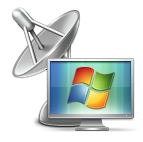
“Remote Desktop Connection.app” allows you to see the desktop of a remote Windows machine on your mac. This application will not update itself automatically, unless you have it installed as part of the Microsoft Office for Mac suite. If you’ve downloaded the 1.0.3 version you probably did not notice that “Remote Desktop Connection.app” was updated somewhere last year by microsoft.
You can find the latest version of Remote Desktop Connection on the Microsoft Mactopia site. Version 2 is an improvement over 1.0.3 (which I had). Notable differences are:
I played with it for a while, and apart form the new looks I can not say it’s very different from the 1.0.x version. It could load my old RDC 1.0.3 configuration files. If you need to connect to a Windows desktop from your Mac, this does the job just fine.
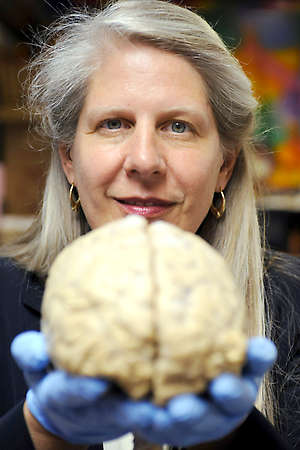 Here’s Jill Bolte Taylor. She’s a brain scientist, studying schyzofrenia, and the micro-circuitry in the human brain which causes these (and other) mental illenesses. On the morning of September 10, 1996 she had a stroke. Amongst all other things that went though her head, she realized that this was a tremendous oportunity because she got to study this phenomena first hand. Luckaly, she fully recovered, wrote a book about it, and did a very impressive presentation about it at the 2008 TED conference, called “a powerful stroke of insight”.
Here’s Jill Bolte Taylor. She’s a brain scientist, studying schyzofrenia, and the micro-circuitry in the human brain which causes these (and other) mental illenesses. On the morning of September 10, 1996 she had a stroke. Amongst all other things that went though her head, she realized that this was a tremendous oportunity because she got to study this phenomena first hand. Luckaly, she fully recovered, wrote a book about it, and did a very impressive presentation about it at the 2008 TED conference, called “a powerful stroke of insight”.
Having watched this presentation, I realized that Zen monks already figured this out a long time ago, without knowing that they were talking about left or right brain halves. Here’s a short recap of what your left and right brain halves do:
 There is a nice and clean way to automatically mount network shares each time you log into your Mac. It’s called the “Bonjour Mounter”, a simple application which runs on login, and mounts the drives you configured it to mount. No more, no less.
There is a nice and clean way to automatically mount network shares each time you log into your Mac. It’s called the “Bonjour Mounter”, a simple application which runs on login, and mounts the drives you configured it to mount. No more, no less.
I recently upgraded the operating system on my trusty Mac Mini G4 home fileserver from Tiger to Leopard. In addition to the out-of-the-box backup, I no longer have to use SharePoints to manage my network shares. In Leopard, I can just right-click them and arrange the sharing.
In doing so, I decided to switch on both SMB and AFP sharing for all shares. The idea was that my Macs all would use AFP automatically, and all Windows machines would see the SMB mounts. After a few hours, iTunes began acting up on me, because it decided to switch between the SMB and AFP protocol (or so it seemed). Finder also seems to have some trouble listing network shares if the exact same name on the same server is shared with two different protocols.
Because there are people on my network with Windows machines, I decided to switch off the AFP protocol and only go with SMB. I haven’t had problems since.
If you’re sharing drives like I’m doing, go for SMB. It may not be the technically superior solution, but it will “just work”. You can easily switch to AFP when the world is freed of Windows machines. 😉
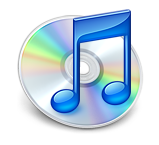 Regular readers know that I’ve been ranting about the way the music and movie industry are selling us crippled content, which actually feels like punishing you for honestly buying your digital content. Coincidentally, a month after that rant, Steve wrote a mail to the music industry in which he stated that DRM clearly was not working, and we needed to approach things differently.
Regular readers know that I’ve been ranting about the way the music and movie industry are selling us crippled content, which actually feels like punishing you for honestly buying your digital content. Coincidentally, a month after that rant, Steve wrote a mail to the music industry in which he stated that DRM clearly was not working, and we needed to approach things differently.
A few months later, Apple and EMI actually started a new service in iTunes called iTunes plus, selling 256kbps DRM-free AAC files. If you’ve seen the latest Macworld 2009 Keynote Address by Philip (Phil) Schiller, you will have noticed that Apple hasn’t been sitting still. At the end of this quarter, all songs in the iTunes store will be available as DRM-free iTunes plus version. And there’s an easy button in iTunes which let’s you upgrade all your DRM-ed music automatically (payed, ofcourse). The link is in the iTunes Quick Links box, top right. I tried it, works fine.
Finally, your music will travel with you and play anywhere, just like those trusty CD’s did. Even better: with your iPhone you’re now able to buy music anywhere you are, because Apple has added 3G to the iTunes store on the iPhone.
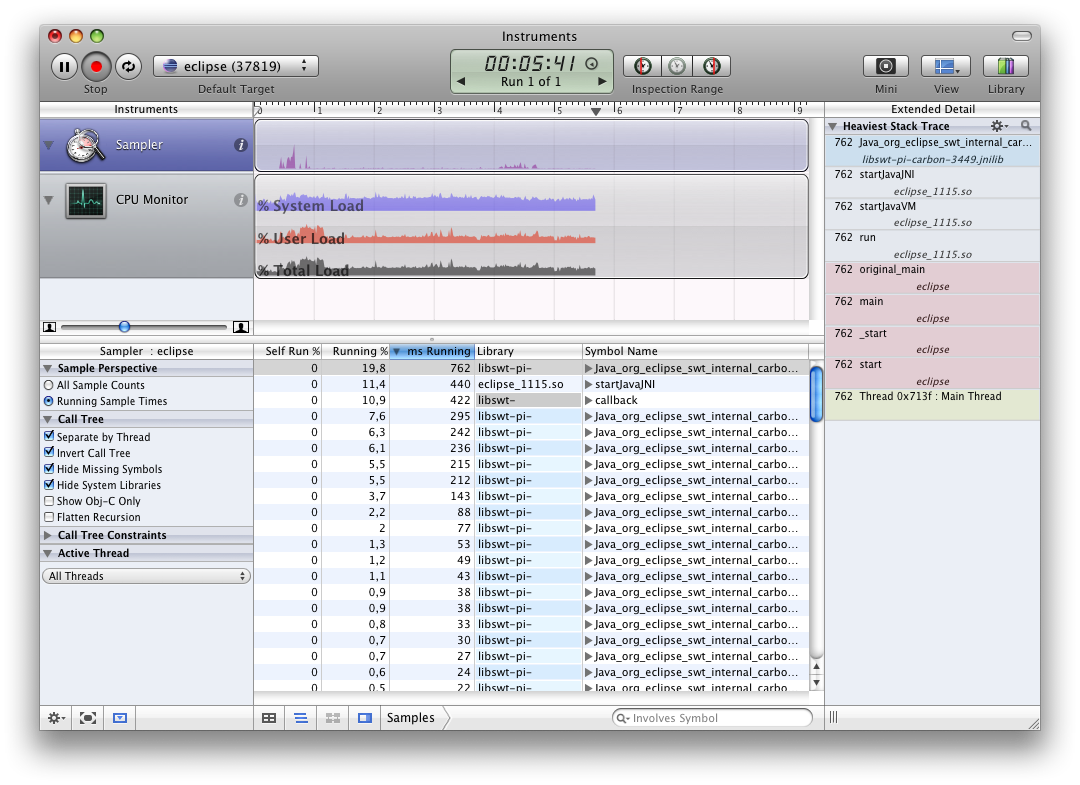 Did you know that your installation of Leopard comes with a built-in performance monitor? It’s called “Instruments” and you can attach it to any process currently running. In the screenshot you see here I attached it to an instance of Eclipse while running some unittests.
Did you know that your installation of Leopard comes with a built-in performance monitor? It’s called “Instruments” and you can attach it to any process currently running. In the screenshot you see here I attached it to an instance of Eclipse while running some unittests.
Instruments has some nice templates for you to choose from, and you can monitor CPU activity per thread, disk I/O, User Interface activity, Object allocations, and leaks. Just so you know, it might come in handy.
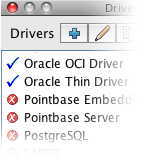 If you’re a SQuirreL SQL fan like me, and you use a Mac, you probably also want to know how to add a driver to the OSX version of the application. Most people just point to an external jar file, but you can also add drivers to the application bundle. There’s not much to it, but it took me some time to discover that I actually had to edit the plist file in the bundle after adding the driver.
If you’re a SQuirreL SQL fan like me, and you use a Mac, you probably also want to know how to add a driver to the OSX version of the application. Most people just point to an external jar file, but you can also add drivers to the application bundle. There’s not much to it, but it took me some time to discover that I actually had to edit the plist file in the bundle after adding the driver.
As you can see on the left, my SQuireLSQL.app now comes with the Oracle OCI and Thin driver built in, and because they are part of the application bundle, I can’t wreck my installation by misplacing jarfiles or reconfiguring classpaths. Nice.
If you want to drivers to your SQuireLSQL.app yourself, here’s what you need to do:

I recently downloaded Eclipse 3.4.1 for Mac OSX, and tried starting it using the eclipse.app icon. It did not work, and I noticed a message in /var/log/system.log telling me that the JVM could not be loaded.